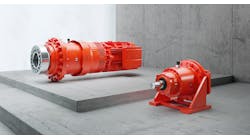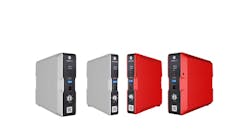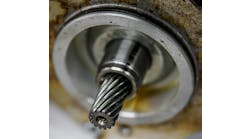There are two things worth noting on how technology is changing motors. "One is the Internet of Things (IoT) trend," says Michael Offik, PE, director of packaged solutions at ABB. "The motors can be inexpensively monitored. The other is the continued push for power density and efficiency. When talking motors, that means you move from induction to something that uses permanent magnets to reduce losses."
With the IoT, plant personnel are able to use low-cost sensors to get data directly from a motor. "Temperature, vibration and other key parameters can be measured," says Offik. "By monitoring the data, the health of the motor can be predicted. People care more and more about reliability. It's not just the initial cost of the equipment, it’s keeping the plant running. To do that, it's necessary to understand if things are running properly and when they might fail."
Condition monitoring, which in the past was just done on large, expensive motors, is moving into something that is low cost and suitable for use on smaller motors, continues Offik. "With Wi-Fi, Bluetooth or Ethernet communication, it's easy to get the data and process it to understand what's going on in a motor," he says. "It's a trend that will continue; and, when things are measured, we'll be able to aggregate it, and a plant engineer, plant manager or operation manager will be able to look at the population of motors and understand how they are running in their plant."
It's becoming easier to get to the motor data, and products are being launched in the United States that are making it happen. For example, the ABB Ability Smart Sensor for motors will be able to connect to smart phones and tablets. It's a device about the size of a cell phone that is attached to the motor. It's battery-powered, takes measurements once per hour and saves four weeks of motor-health and key-performance-indicator data. It can be read by a smart phone using an app where it is uploaded to the cloud. Users can connect via a portal, and the uploaded measurement data can be viewed and understood. Instead of just physically, maybe once a quarter, connecting vibration and temperature sensors to a motor and taking a few hours or days of readings and then processing them, now something can be installed on a motor that is low cost, and a user can take readings just by being within Bluetooth range. The collected data is sent to the cloud where trends can be viewed in finer detail.
Another thing driving the motor industry is efficiency. "Although legislation hasn't moved quickly in the pump and fan worlds, industry is starting to take a more system view," says Offik. "In the past, it was just about the motors meeting a certain level of efficiency. Now a fan system from the power in—kilowatts—to the air flow out has to be a certain efficiency. The Air Movement and Control Association (AMCA) is a good source of information on these developing standards. You will only be allowed so many Watts to move a certain amount of air."
These future standards are driving the next level of efficiency beyond current NEMA premium and IEC IE3 standards. Now it's moving to NEMA super premium and ultra premium motor efficiency standards, which will be similar to IEC IE4 and IE5 standards. These standards will be difficult to meet with induction motors due to losses in the rotor where a magnetic field must be induced in copper or aluminum bars.
"The way to meet future efficiency standards is through permanent-magnet technology where there is no need to induce the magnetic field,” says Offik. "Permanent-magnetic motors have been used in servo motors for years, as well as large synchronous motors, but they are now becoming more prevalent in the everyday pump and fan motors."
People are also becoming used to using motor drives, which are typically needed to run a permanent-magnet motor. "It's not just a servo drive; there are several designs of permanent-magnet motors," says Offik. "The magnet configuration and type of magnetic material in the motor affects the drive design. There will be tight compatibility between a motor and a drive, as well as future integration of motor and drives at some level. There is some of that now, but I think it could grow quite a bit in the next few years."
If you just apply a sine wave to the permanent-magnet motor, it won't start or run properly, but there is an exception. A line-start permanent-magnet motor provides better efficiency than an induction motor, IE4 or better, and is a NEMA drop-in replacement. It works for across-the-line pumps, due to their low inertia, and can be used with variable frequency drives for higher inertia loads. And of course, 10% less motor speed uses about 50% less power, so it may further lower operation costs.
It's also what the automotive guys are using. "Permanent-magnet motors are primarily used in electric vehicles because of the power density,” says Offik. "It reduces the size and weight of the vehicle but still has significant torque available. This will affect the industrial world because they will be using much of the same materials needed in the industrial space. While it may drive costs down due to automation, it creates more demand for the raw materials."






